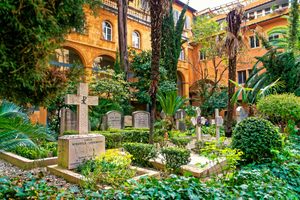Getting into the Campo Santo Teutonico, or “Teutonic Cemetery”, a centuries-old cemetery and former refuge for German-speaking pilgrims, already feels a bit special. Walk up to the Vatican gate, follow the Via Paolo VI and you will reach the Swiss Guards standing there in their orange, blue and red uniforms.
Instead of the usual Italian or English, greet them in German or even Swiss German. They’ll understand, give you a quick nod and wave you through. Right after that comes a small security check and then the buzz of the city fades behind you.
Even though you reach the Campo Santo Teutonico by walking past the Swiss Guards and through Vatican security, it isn’t actually Vatican territory. It’s technically part of Italy, just quietly tucked inside the Vatican walls like a little guest room that never moved out.
Inside, everything slows down. Here, behind Saint Peter’s, it’s just you, the ancient air and those gravestones whispering stories from centuries of German-speaking theologians, scholars, artists, priests and pilgrims like Anton de Waal, Hermine Speier, Hermann Maria Stoeckle and Wilhelm Achtermann.
The cemetery is compact, more like a quiet garden. Ivy creeps over old brick walls and marble crosses and skull motifs peek out from all directions. The area is said to have been gifted by Pope Leo III to Charlemagne in 799 to build a school, hospice and cemetery for the many germanic pilgrims coming to visit the tomb of Saint Peter.
If you feel like digging deeper into the names on the graves and the long history of the cemetery, keep an online encyclopedia close by because it will send you down some fascinating rabbit holes.
